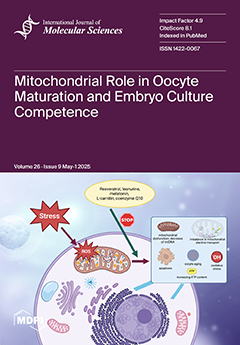Regulating chloroplast gene expression is crucial for maintaining chloroplast function and plant development. Pentatricopeptide repeat (PPR) proteins form a vast protein family that regulates organelle genes and has multiple functions during plant development. Here, we found that two P-type PPR proteins, YS1 (yellow-green
[...] Read more.
Regulating chloroplast gene expression is crucial for maintaining chloroplast function and plant development. Pentatricopeptide repeat (PPR) proteins form a vast protein family that regulates organelle genes and has multiple functions during plant development. Here, we found that two P-type PPR proteins, YS1 (yellow-green seedling 1) and YS2, jointly regulated seedling development in rice. The loss of
YS1 and
YS2 exhibited the collapsed chloroplast thylakoids and decreased photosynthetic activity, leading to the yellowing and death of rice seedlings. YS1 and YS2 could directly bind to the transcript of the
psbH-petB intergenic region to facilitate the splicing of
petB intron, thereby affecting the splicing efficiency of
petD, which is located downstream of
petB in the five-cistronic transcription unit
psbB-psbT-psbH-petB-petD. The mutations in
YS1 and
YS2 led to decreased mature transcripts of
petB and
petD after splicing, significantly reducing the protein levels of PetB and PetD. This further led to deficiencies in the cytochrome b6/f and photosystem I complexes of the electron transport chain (ETC), ultimately resulting in decreased ETC-produced NADPH and reduced contents of carbohydrates in
ys mutants. Moreover, transcriptome sequencing analysis revealed that YS1 and YS2 were vital for chloroplast organization and carbohydrate metabolism, as well as chloroplast RNA processing. In previous studies, the mechanism of
petB intron splicing in the five-cistronic transcription unit
psbB-psbT-psbH-petB-petD of rice is unclear. Our study revealed that the two highly conserved proteins YS1 and YS2 were functionally redundant and played critical roles in photosynthesis and seedling development through their involvement in
petB intron splicing to maintain chloroplast homeostasis in rice. This work broadened the perspective on PPR-mediated chloroplast development and laid a foundation for exploring the biofunctions of duplicated genes in higher plants.
Full article






